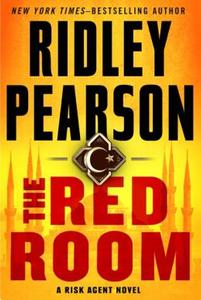 Ridley Pearson is the author of more than 48 novels, divided almost equally between suspense and young adult adventure. Over the years, his work has been published in two dozen languages, and has been adapted by network television and for the Broadway stage. He recently concluded his middle-grade Kingdom Keepers series with The Insider; his most recent novel, The Red Room (reviewed below), continues his Risk Agent international thriller series for adults.
Ridley Pearson is the author of more than 48 novels, divided almost equally between suspense and young adult adventure. Over the years, his work has been published in two dozen languages, and has been adapted by network television and for the Broadway stage. He recently concluded his middle-grade Kingdom Keepers series with The Insider; his most recent novel, The Red Room (reviewed below), continues his Risk Agent international thriller series for adults.
While doing research for a book he published in the early '90s, Pearson took an in-depth tour of an FBI field office. As he and his guide came upon a bank vault, Pearson asked what it was--possibly an armory or a property lock-up? The guide had Pearson turn away so he could covertly key in a code and open the door. Pearson recalled, "When the vault door swung open, there was a bare bulb, a table, a chair and a man sitting there. I walked in, shook his hand, and walked out. To this day, I have no idea what that dude was doing in there, but that became the idea for the vault at the beginning of The Red Room."
Pearson's research experiences have provided him with a wealth of knowledge and story ideas, but sometimes it's the inadvertent experiences that make it into the books. That was the case for the beginning of the Risk Agent series. After teaching creative writing in China for a year, Pearson returned, intending to continue his Walt Fleming series about a sheriff in Sun Valley, Idaho. But when his agent asked if he could use any material from his time in Shanghai, he jumped at the chance. "I was a great fan of the early Follett and Ludlum novels, even Arthur Conan Doyle," Pearson said. Having been steered away from his espionage work to traditional procedurals by his early editors, the author was excited to turn back to the style that originally attracted him to the crime genre.
However, it was important that character still play a prominent role in his work. Pearson credits his editors for keeping him on track: "I have two women editors who are aware of my desire to maintain characterization and not just turn these things into shoot-'em-ups." In fact, it was one of those editors, Christine Pepe, who encouraged Pearson to develop balanced protagonists for the Risk Agent series, which stars independent security contractors John Knox and Grace Chu. Pearson says creating that balance has been a juggling act: "It took nine drafts of Choke Point [2013] to get to where both characters were being dealt with in equal balance."
John Knox is based on private contractors working in Iraq, while Grace Chu is an amalgam of the female students Pearson taught while in China. The two have a bit of a yin and yang relationship driven by their cultures, as Grace observes in The Red Room, equating Knox's "much-heralded American ability to create and innovate with her own tendency toward rote technical skills."
In addition to his human characters, Pearson believes, "Setting has to be a character. You can't write the book and say, 'this could be Indianapolis or Denver or wherever.' You owe it to the reader to make the setting that important." And in order to make the setting authentic enough for readers, he needed to personally see and experience the places in his novels... until Choke Point. "I went to Amsterdam for less than a week, and I took my assistant with me. We shot umpteen zillion photographs, but on the last day my assistant's iPhone was stolen and we lost all the research."
Crushed, he returned home with no idea how he could re-create everything that was lost. The experience became a turning point in Pearson's writing career: "I came home and found out Amsterdam is on Google Street View! I revisited everything we saw in Amsterdam, and then I went through home-shot YouTube videos and visited virtually with the families who created them. The ability to virtually research a place shocked me."

As Pearson learned on his most recent research trip, sometimes visiting a location provides you with more than just a feel for the environment. In Nairobi, Kenya, the location for his next Risk Agent novel, he discovered his last three months of planning and outlining would have to be thrown out. He said, "The story I want to write is so deep and I wasn't playing it out in enough levels. I was painting the story in two dimensions when it should be eight or nine."
One of Pearson's goals with the social issues he weaves into his books is to show all sides of a conflict, all the shades of gray. But in this new story, he says, "the world that it's in is so many shades of gray, I won't be able to illustrate them all."
In The Red Room, he let Grace Chu and John Knox help muddy the story waters for him: "Where I would normally speculate, I let the characters do it. Grace and Knox roll over a rock and their discovery gives them multiple options. They choose one and find another rock that presents new options and so on." It's this "rock rolling" that helps build the suspense and mystery of the plot as well.
When Pearson reads a book, he says, "It can't just be a joyride. I want to learn something I didn't know before or come out of the book curious about something." And his hope is that he provides that for his own readers: "One thing I've learned by writing about Disney [his Kingdom Keepers series is set in Disney theme parks]--every attraction tells a story. The imagineers spend months or even years writing the story through images, signs and so on. Many people never notice it, but they experience it."
Pearson points out that "striving for [more than a joyride] and accomplishing it are two different animals. It's what I aim for." And again, he sings the praises of his editors in helping him hit his mark and ensuring he creates the best book he can. In turn, he credits his music writing background for helping him learn the value of his editors. "As a songwriter, you learn that the bass player's idea about what he should sound like is as important as your idea. I want the help. I want to collaborate. I'm aware I make mistakes."
With so many balls in the air at any given time, you'd think something would fall. But Pearson says it keeps him fresh, "Generally I work on thrillers all morning, take a very short lunch, then work on everything else in the afternoon." After finishing up work in the morning, he's excited to get back to his middle-grade book in the afternoon and, at the end of the day, he looks forward to starting back in the next day on his thriller.
He also uses an unusual hobby to keep his mind clear: he climbs trees! Pearson assures us it doesn't hurt the trees, but the activity itself is "playful and joyful and freeing. You can't be thinking about anything else or you'll wipe out. I love it because it takes me right into NOW. You're totally in the now and you come out of it very refreshed."
And if he isn't refreshed enough, his contact with his fans provides another source of inspiration. Talking about his young readers, he says, "There's nothing like that connection--to see the light and connection in a child's eye. It makes you get up in the morning." He's found social media provides that connection as well. A young girl who was suicidal but found hope in the Kingdom Keepers bestowed a precious gift on Pearson when he heard the story through his social media channels. "It's such a privilege to be published. You don't do anything without your readers."
And, in return, Ridley Pearson gives readers the gift of story. That's a pretty good trade. --Jen Forbus of Jen's Book Thoughts

